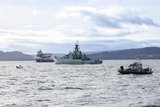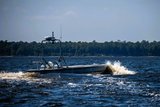Thales to support UK Royal Navy fleet communications for next 10 years
Fleetwide communication, and communication between ship and shore, are critical in the Royal Navy. (Photo: Royal Navy/Crown copyright)
Thales UK has won a contract with the UK's Defence Equipment & Support (DE&S) agency to maintain the RN’s internal and external fleet communications and provide global 24/7 support operations for the next 10 years.
The Maritime Communications Capability Support (MCCS) deal amounts to one of the largest investments in naval communications across Europe. It has been estimated that the new contract will save the RN up to £30m (US$37 million) in through-life costs over the next decade.
Communications failures on RN vessels or at shoreside stations can risk their ability to fulfil their mission objectives, ultimately jeopardising strategic defence outcomes. That means the communication systems deployed by the RN are required to be resilient and robust.
Related Articles
UK upgrades threat detection systems on its Royal Navy warships
Royal Navy’s Type 31 frigate to use half the crew of the Type 23 and embrace automation
Thales has history in ensuring communications resilience for the RN and it previously delivered fleetwide communications services across RN vessels.
The new contract though replaces the previous fleetwide communications contract, which has been in effect for seven years to date.
The projected £30 million of savings, Thales said, will come from significant reductions in red tape, coming as a result of a new “one defence” approach. That means closer collaboration between the RN, the DE&S, and Thales UK.
Thales will be able to circumvent previous equipment replacement processes in the RN infrastructure in order to sustain communications capability long-term. No exact costs for the 10-year contract were released with the announcement of the deal.
More from Naval Warfare
-
![How the Anduril-HHI autonomous ship plan fits in with the US Navy’s MASC programme]()
How the Anduril-HHI autonomous ship plan fits in with the US Navy’s MASC programme
The new modular vessel is expected to be developed for both commercial and defence use, with a heavy focus on production speed and mission flexibility.
-
![Indo Pacific 2025: Autonomous systems reigned but can the Australian Defence Force afford it?]()
Indo Pacific 2025: Autonomous systems reigned but can the Australian Defence Force afford it?
Multiple autonomous systems and technologies were on display at this year’s Indo Pacific, but questions remain over how the Australian Department of Defence will balance the books.
-
![How the UK Royal Navy is powering up its hybrid fleet to combat new threats]()
How the UK Royal Navy is powering up its hybrid fleet to combat new threats
Since it announced its move towards a new “hybrid navy” earlier this year, the force has announced a number of new uncrewed technologies in the works.
-
![US and UK to begin Trident II D5 Increment 8 in October 2026]()
US and UK to begin Trident II D5 Increment 8 in October 2026
Trident II D5 Increment 8 will involve improvements to the shipboard navigation subsystem for the US Ohio and Columbia and the UK Dreadnought and Vanguard submarine classes.
-
![US Navy starts acquisition process for uncrewed maritime systems for support missions]()
US Navy starts acquisition process for uncrewed maritime systems for support missions
The USN is interested in uncrewed capabilities that can carry out explosive ordnance disposal, mine countermeasures, force protection, ISR and anti-submarine missions.























